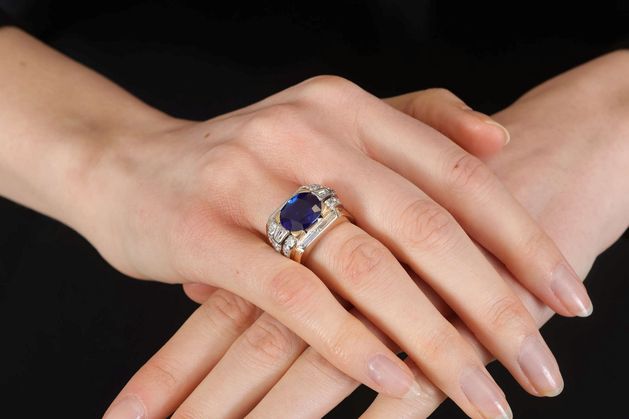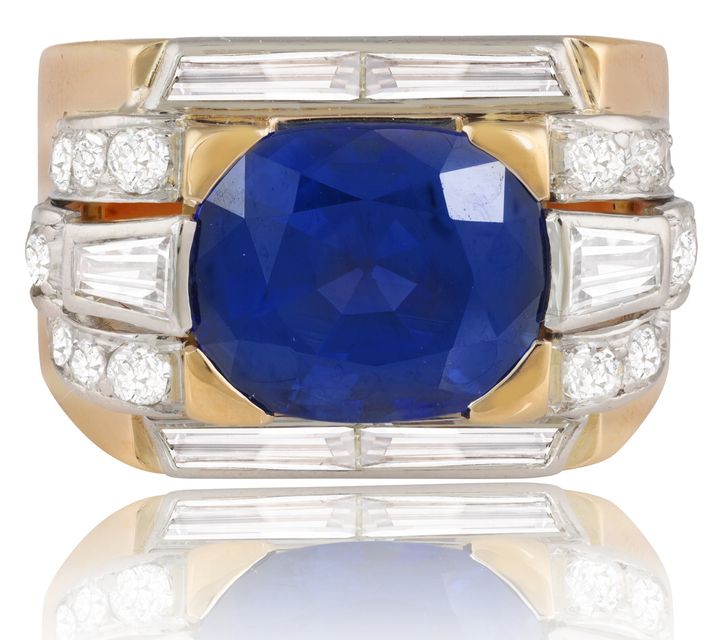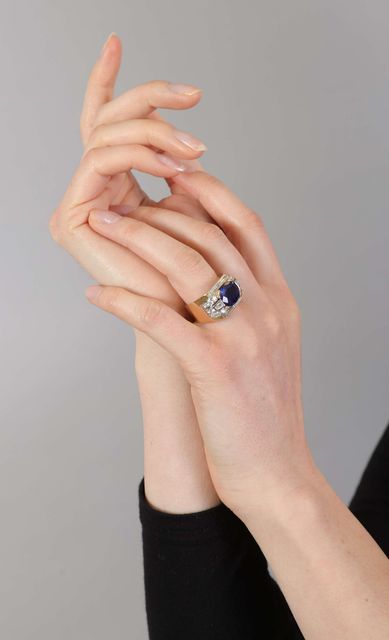The hitherto undiscovered stone recently had its source verified by multiple experts, adding an extra zero to its valuation
The discovery put another zero on the price. Kashmir sapphires are the rarest, finest and most beautiful in the world. They come from the Zanskar range of the Himalayas, and were mined between 1882 and 1887.
The stone (Lot 23: est €150,000 to €250,000) is going under the hammer at Adam’s sale of Fine Jewellery and Ladies’ Watches on May 13.
It’s unusual for Kashmir sapphires – from a mine only open for five years – would have a 1940s setting, as most are Victorian
The story of Kashmir sapphires reads like historical fiction. In 1890, Tom D LaTouche, the deputy superintendent of the Geological Survey of India, described how the first sapphires were brought into Shimla, now in Himachal Pradesh, in India.
They had been uncovered in “the mountains on the borders of Zanskar, where a landslip had laid bare the rocks beneath the soil, and disclosed the presence of the gems.”
LaTouche tells the tale of a shikari (hunter) who lost the flint from his gun while hunting and, with no other way of lighting his pipe, searched for a piece of rock to strike a spark. He “picked up a small sapphire, and finding that it answered his purpose better than the ordinary fragments of quartz he was in the habit of using, carried it about with him for some time.” Eventually, the hunter sold the stone to a Laholi trader, from “whom it was taken to Simla, where its value was recognised.”
Enquiries were made, the location was discovered, and guards were posted to prevent the locals from selling the stones at what LaTouche describes as “absurdly low prices, the Laholis only asking about one rupee per seer for them.”
Now, they can fetch astounding prices at auction. On April 25, an 11.56 carat Kashmir sapphire and diamond ring sold at Sotheby’s in Hong Kong for HKD $6,350,000 (€721,514).
“I think this is the first time a Kashmir sapphire has been auctioned in Ireland,” says Claire-Laurence Mestrallet, head of jewellery at Adam’s.
Kashmir sapphires have an intense blue colour and a velvety appearance
The stone is mounted in a retro sapphire and diamond ring, circa 1940, and catalogued as “of tank design, centring a cushion-shaped sapphire weighing 6.22cts, between old brilliant and tapered baguette-cut diamond shoulders, and between baguette-cut diamond borders.”
It comes from a private collector in France, who bequeathed the collection to her son. Before the stone was identified as a Kashmir sapphire, it was expected to sell for between €8,000 and €12,000.
A fine, classical Kashmir sapphire can be sold for many times more than a Madagascar sapphire of exceptional quality and size
It’s famously impossible to identify a Kashmir sapphire by sight, but something in the quality of the stone alerted Mestrallet to the possibility.
“Kashmir sapphires have an intense blue colour and a velvety appearance,” she says. “It’s unusual to find one in a 1940s ring.” Because of the short period of their mining, most Kashmir sapphires were mounted in Victorian jewellery.
The stone was removed from its setting and sent to a Gemmological Certification Services (GCS) London for testing and pronounced “of Kashmir origin, with no indications of heating.”
These milky bands are the cause of the sleepy, velvety texture so admired in fine Kashmir sapphires
Many sapphires are heated at extremely high temperatures to intensify their colour and improve their clarity. This one is a natural stone.
It then went off to Switzerland where the Swiss Gemmological Institute (SSEF) confirmed it as a Kashmir sapphire.
Finding out where a sapphire came from is neither straightforward nor easy. A hundred years ago, it was much less of a problem. Then, according to an article in Gems & Gemology (2019), the only major sources of these sapphires were Kashmir, Myanmar and Sri Lanka.
About 25 years ago, Madagascar started producing large volumes of sapphires. Since “a fine, classical Kashmir sapphire can be sold for many times more than a Madagascar sapphire of exceptional quality and size”, finding out the source is undertaken with care and deliberation.
All the information about Kashmir sapphires comes from historic stones with provenance that can be proven. “The mine was only open for five years,” Mestrallet explains. “Then it closed. It’s been closed for more than 100 years.”
Sapphires can be identified by mineral inclusions (materials trapped within the crystal’s structure) or by identifying the “patterns of silk and particle clouds” within the stones, which are described in a language akin to poetry: “These milky bands are the cause of the sleepy, velvety texture so admired in fine Kashmir sapphires.”
See adams.ie
#Rare #Kashmir #sapphire #diamond #ring #1940s #setting #hammer #Irish #auction









